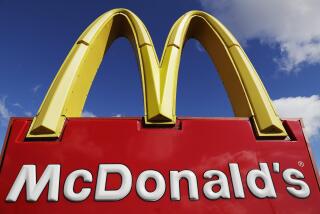Calorie labeling may make a difference -- if customers notice
- Share via
Calorie labeling in fast food restaurants is part of the landscape, but is it making a difference in what customers buy? A study finds that it can, if people pay attention to the information.
Researchers compared purchases and calories among fast food diners in New York City in 2007, a year before calorie labeling legislation started and in 2009, nine months after it became law.
In 2007, 7,309 customers were surveyed, and in 2009, 8,489 people took part. Researchers conducted the study among 168 randomly selected restaurants among the top 11 fast food chains in the city.
Overall calories didn’t decrease in the meals purchased during both years. However, the 15% of customers who used the calorie information bought food that contained, on average, 106 fewer calories than food purchased by people who didn’t see or use the information.
Calorie differences were seen among some of the chains: at Au Bon Pain, overall calories went down by 14.4%; at McDonald’s they decreased by 5.3%; and at KFC they declined by 6.4%. These chains made up 42% of all the customers surveyed.
Those calorie reductions, write the authors, may be chalked up to the restaurants having broader menus and more choices than others. Some of those choices were even advertised as being lower in calories--Au Bon Pain, for example, began offering a “Portions” menu in 2008 that, according to its website, includes items that are “nutritious, healthy [and] low in calories,” as in less than 200.
Customers at one chain, however, increased their calorie consumption. At Subway restaurants, average calorie consumption went up 17.8% The irony wasn’t lost on the researchers, who noted that the chain heavily promotes some of its subs as being low in calories and fat. Apparently that wasn’t enough to stop customers from buying the highly advertised (and higher in calories) $5 foot-long subs. The authors note that in 2007 one out of four Subway customers bought the $5 sandwich, while in 2009 it was three out of four.
Previous studies on the influence of calorie labeling have shown mixed results--sometimes it makes a difference in overall calories consumed, sometimes it doesn’t. The authors of this study, published recently in the British Medical Journal, noted that calorie labeling legislation may compel restaurants to offer more healthful foods, or to lower the fat and calories in their most popular menu items. But, they add, calorie labeling alone won’t make enough of a difference in obesity rates--more needs to be done, including educating customers on how to understand and use nutritional information.
More to Read
Eat your way across L.A.
Get our weekly Tasting Notes newsletter for reviews, news and more.
You may occasionally receive promotional content from the Los Angeles Times.










